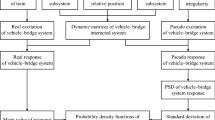Abstract
The paper deals with the reliability analysis for the high-speed railway bridge systems. Although the bridge–vehicle interactive system has much more uncertainties in the resistance and loads of trains moving at very high speed compared with static structural analysis, little concern has been engaged to identify which random variable has to be considered in the probabilistic analysis, or what criteria should be selected to determine the probabilistic safety or serviceability. The considered design parameters thus involve uncertainties in stiffness, moment of inertia, damping ratio of primary suspension in terms of load, geometry of girders and slabs, and the mechanical properties of girders in terms of resistance. The considered limit states embrace the safety of trains and comfort of passengers, and the acceptability criteria are based on UIC code. For evaluating the reliability of the time-dependent nonlinear behavior of complex structures, an improved Response Surface Method (RSM) is developed. An adaptive technique and a weight matrix are utilized as an optimizing technique that accelerates the convergence in the reliability analysis. The results of improved RSM, compared with the basic and adaptive RSM, are verified with the improved convergence to the exact solution. The bridge response is analyzed using a new three-dimensional finite element model of high-speed train–bridge interactions. The track structures are idealized using beam elements with the offset of beam nodes and beams on a two-parameter elastic foundation. The vehicle model developed for a 300 km/h train is employed. The calculated reliabilities for performance of the considered bridges and the passenger comfort on board of high-speed trains are compared to the conventional safety indices. The results of this study allow identifying the quantification of uncertainties that can control quality of the high-speed train service.
Similar content being viewed by others
References
O’Connor, C., Chan, T.H.T.: Dynamic loads from bridge strains. ASCE J. Struct. Eng. 114, 1703–1723 (1988)
Law, S.S., Chan, T.H.T., Zeng, Q.H.: Moving force identification: a time domain method. J. Sound Vib. 201(1), 1–22 (1997)
Law, S.S., Chan, T.H.T., Zeng, Q.H.: Moving force identification: a frequency and time domains analysis. ASME J. Dyn. Syst. Meas. Control 12(3), 394–401 (1999)
Chan, T.H.T., Law, S.S., Yung, T.H., Yuan, X.R.: An interpretive method for moving force identification. J. Sound Vib. 219(3), 503–524 (1999)
Lin, J.H.: Response of a bridge to a moving vehicle load. Can. J. Civil Eng. 33(9), 49–57 (2006)
D’Aveni, A., Muscolino, G., Ricciardi, G.: Stochastic analysis of a simply supported beam with uncertain parameters subjected to a moving load. Struct. Dyn. 1, 439–446 (1996)
Hwang, E.S., Nowak, A.S.: Simulation of dynamic load for bridges. ASCE J. Struct. Eng. 117(5), 1413–1434 (1991)
Nassif, H., Nowak, A.S.: Dynamic load spectra for girder bridges. Transp. Res. Rec. 1476, 69–83 (1995)
Minasny, B., McBratney, A.B.: A conditioned Latin hypercube method for sampling in the presence of ancillary information. Comput. Geosci. 32(9), 1378–1388 (2006)
Janssens, D., Wets, G., Brijs, T., Vanhoof, K.: The development of an adapted Markov chain modelling heuristic and simulation framework in the context of transportation research. Expert Syst. Appl. 28(1), 105–117 (2005)
Hisada, T., Nakagiri, S.: Role of stochastic finite element method in structural safety and reliability. In: Proceedings of the Fourth International Conference on Structural Safety and Reliability, ICOSSAR’85, pp. 385–395 (1985)
Ghanem, R.G., Spanos, P.D.: Stochastic Finite Elements for Spectral Approach. Springer, Berlin (1991)
Takada, T.: Weighted integral method in stochastic finite element analysis. Probab. Eng. Mech. 5(3), 146–156 (1990)
Deodatis, G., Shinozuka, M.: The weighted integral method, II: response variability and reliability. J. Eng. Mech. 117(8), 1865–1877 (1991)
Box, G.E.P., Wilson, K.B.: On the experimental attainment of optimum conditions. J. R. Stat. Soc. Ser. B 13, 1–45 (1951)
Bucher, C.G., Bourgund, U.: A fast and efficient response surface approach for structural reliability problems. Struct. Saf. 7(1), 57–66 (1990)
Rajaschekhar, M.R., ELlingwood, B.R.: A new look at the response surface approach for reliability analysis. Struct. Saf. 12, 205–220 (1993)
Engelund, S., Rackwitz, R.: A benchmark study on importance sampling techniques in structural reliability. Struct. Saf. 12(4), 255–276 (1993)
Guan, X.L., Melchers, R.E.: Effect of response surface parameters variation on structural reliability estimates. Struct. Saf. 23, 429–444 (2001)
Nowak, A.S., Cho, T.: Prediction of the combination of failure modes for an arch bridge system. J. Constr. Steel Res. 63, 1561–1569 (2007)
Lee, S.H., Kwak, B.M.: Response surface augmented moment method for efficient reliability analysis. Struct. Saf. 28, 261–272 (2006)
Kim, S., Na, S.: Response surface method using vector projected sampling points. Struct. Saf. 19(1), 3–19 (1997)
Kaymaza, I., McMahonb, C.A.: A response surface method based on weighted regression for structural reliability analysis. Probab. Eng. Mech. 20, 11–17 (2005)
Rackwitz, R., Fiessler, B.: Structural reliability under combined random load sequences. Comput. Struct. 489–494 (1978)
Song, M.K., Noh, H.C., Choi, C.K.: A new three-dimensional finite element analysis model of high-speed train–bridge interactions. Eng. Struct. 25, 1611–1626 (2003)
Choi, C.K., Chung, K.Y., Lee, T.Y.: A direct integration method for strains due to nonconforming modes. Int. J. Struct. Eng. Mech. 11(3), 325–340 (2001)
UIC Code 776-1. International Union of Railways (2006)
ERRI D 214: Rail Bridges for Speeds >200 km/h. RP9, European Rail Research Institute, pp. 21–24, 152–154 (1999)
Ministry of Construction and Transportation: Development of Safety in High-Speed Train in Korea, Table 5.4.1 (2000)
Author information
Authors and Affiliations
Corresponding author
Rights and permissions
About this article
Cite this article
Cho, T., Song, MK. & Lee, D.H. Reliability analysis for the uncertainties in vehicle and high-speed railway bridge system based on an improved response surface method for nonlinear limit states. Nonlinear Dyn 59, 1–17 (2010). https://doi.org/10.1007/s11071-009-9521-0
Received:
Accepted:
Published:
Issue Date:
DOI: https://doi.org/10.1007/s11071-009-9521-0



